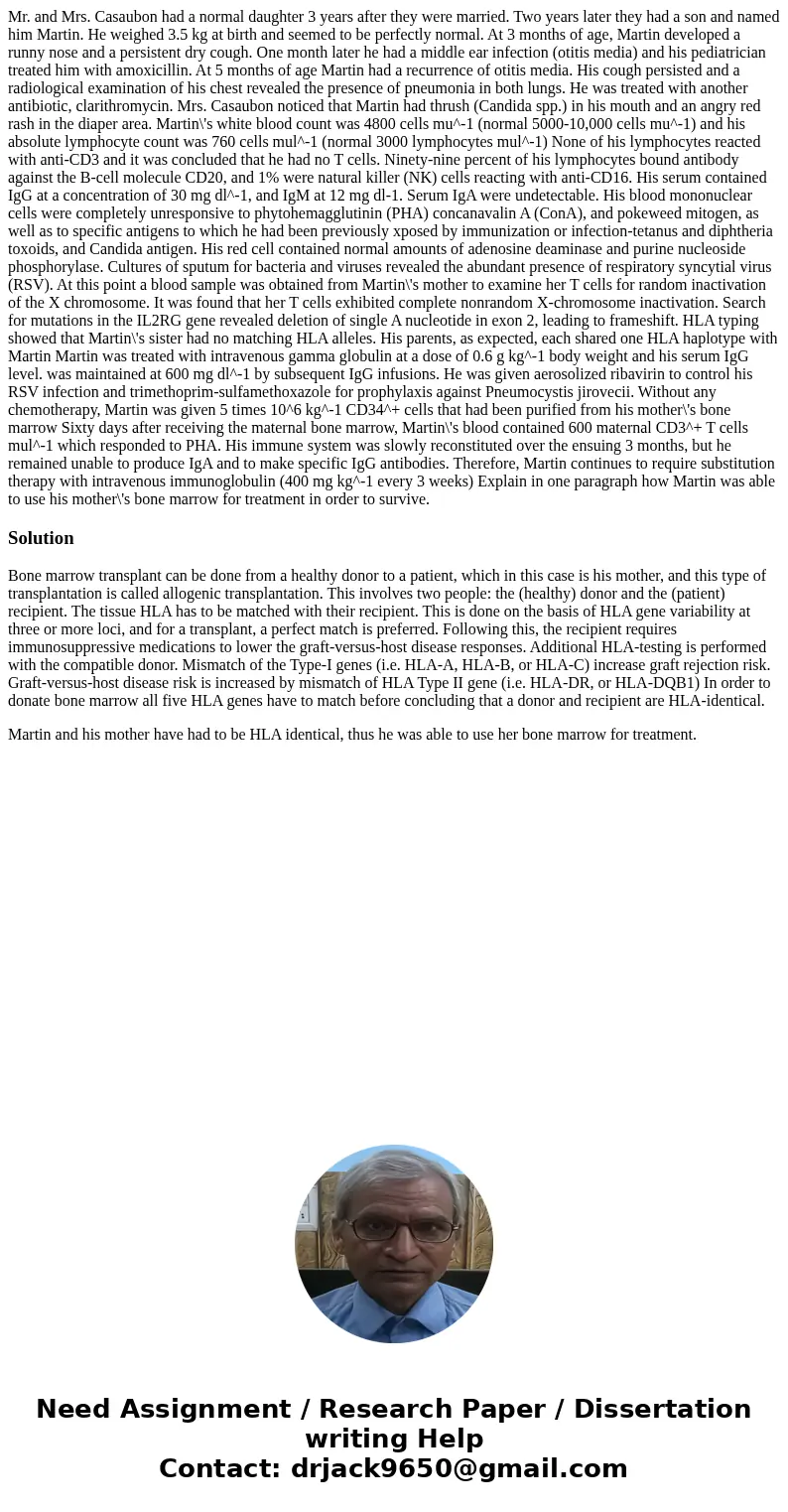Mr. and Mrs. Casaubon had a normal daughter 3 years after they were married. Two years later they had a son and named him Martin. He weighed 3.5 kg at birth and seemed to be perfectly normal. At 3 months of age, Martin developed a runny nose and a persistent dry cough. One month later he had a middle ear infection (otitis media) and his pediatrician treated him with amoxicillin. At 5 months of age Martin had a recurrence of otitis media. His cough persisted and a radiological examination of his chest revealed the presence of pneumonia in both lungs. He was treated with another antibiotic, clarithromycin. Mrs. Casaubon noticed that Martin had thrush (Candida spp.) in his mouth and an angry red rash in the diaper area. Martin\'s white blood count was 4800 cells mu^-1 (normal 5000-10,000 cells mu^-1) and his absolute lymphocyte count was 760 cells mul^-1 (normal 3000 lymphocytes mul^-1) None of his lymphocytes reacted with anti-CD3 and it was concluded that he had no T cells. Ninety-nine percent of his lymphocytes bound antibody against the B-cell molecule CD20, and 1% were natural killer (NK) cells reacting with anti-CD16. His serum contained IgG at a concentration of 30 mg dl^-1, and IgM at 12 mg dl-1. Serum IgA were undetectable. His blood mononuclear cells were completely unresponsive to phytohemagglutinin (PHA) concanavalin A (ConA), and pokeweed mitogen, as well as to specific antigens to which he had been previously xposed by immunization or infection-tetanus and diphtheria toxoids, and Candida antigen. His red cell contained normal amounts of adenosine deaminase and purine nucleoside phosphorylase. Cultures of sputum for bacteria and viruses revealed the abundant presence of respiratory syncytial virus (RSV). At this point a blood sample was obtained from Martin\'s mother to examine her T cells for random inactivation of the X chromosome. It was found that her T cells exhibited complete nonrandom X-chromosome inactivation. Search for mutations in the IL2RG gene revealed deletion of single A nucleotide in exon 2, leading to frameshift. HLA typing showed that Martin\'s sister had no matching HLA alleles. His parents, as expected, each shared one HLA haplotype with Martin Martin was treated with intravenous gamma globulin at a dose of 0.6 g kg^-1 body weight and his serum IgG level. was maintained at 600 mg dl^-1 by subsequent IgG infusions. He was given aerosolized ribavirin to control his RSV infection and trimethoprim-sulfamethoxazole for prophylaxis against Pneumocystis jirovecii. Without any chemotherapy, Martin was given 5 times 10^6 kg^-1 CD34^+ cells that had been purified from his mother\'s bone marrow Sixty days after receiving the maternal bone marrow, Martin\'s blood contained 600 maternal CD3^+ T cells mul^-1 which responded to PHA. His immune system was slowly reconstituted over the ensuing 3 months, but he remained unable to produce IgA and to make specific IgG antibodies. Therefore, Martin continues to require substitution therapy with intravenous immunoglobulin (400 mg kg^-1 every 3 weeks) Explain in one paragraph how Martin was able to use his mother\'s bone marrow for treatment in order to survive.
Bone marrow transplant can be done from a healthy donor to a patient, which in this case is his mother, and this type of transplantation is called allogenic transplantation. This involves two people: the (healthy) donor and the (patient) recipient. The tissue HLA has to be matched with their recipient. This is done on the basis of HLA gene variability at three or more loci, and for a transplant, a perfect match is preferred. Following this, the recipient requires immunosuppressive medications to lower the graft-versus-host disease responses. Additional HLA-testing is performed with the compatible donor. Mismatch of the Type-I genes (i.e. HLA-A, HLA-B, or HLA-C) increase graft rejection risk. Graft-versus-host disease risk is increased by mismatch of HLA Type II gene (i.e. HLA-DR, or HLA-DQB1) In order to donate bone marrow all five HLA genes have to match before concluding that a donor and recipient are HLA-identical.
Martin and his mother have had to be HLA identical, thus he was able to use her bone marrow for treatment.

 Homework Sourse
Homework Sourse